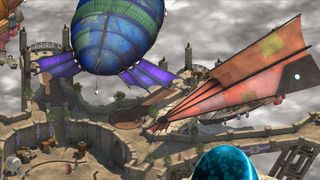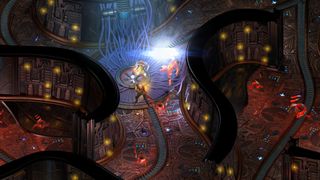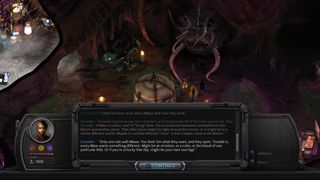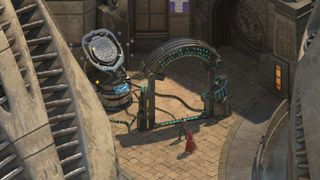Torment: Tides of Numenera preview – A classic series reborn for Xbox One
Torment: Tides of Numenera takes it back to the good old days – but it might not be for everyone.

Role-playing experiences have always been a huge component of the games industry, pushing unmatched narratives and character development built around the player. However, with the genre having undergone significant changes over the past decade, many titles continue to move away from the immersive, tailored storylines which once made them unique.
Among the successes of the late 90's, Planescape: Torment is a title that continues to receive praise to this day. Taking place in the Dungeons and Dragons campaign setting of the same name, the game earned unanimous acclaim for its deep lore. With an expansive, dynamic world and infinite opportunities, Planescape: Torment delivered a truly immersive take on the classic, role-playing formula, rammed with highly-customizable progression, strategic turn-based combat, and a wide and branching narrative.
Torment: Tides of Numenera launches on February 28th for Xbox One and Windows PCs, with PlayStation 4, Mac and Linux versions also available.
Almost 20 years later, we're now set to get a follow-up to the classic, with the upcoming release of Torment: Tides of Numenera. Coming off the back of a successful crowdfunding campaign, which raised $4,188,927, it's clear there's still widespread demand for a return to that golden cRPG era.
It's striking at first how close Tides of Numenera aligns with the original game's vision
In the hands of inXile Entertainment, Torment: Tides of Numenera hopes to capture the original game's strengths in a modernized package. With a team housing some of the masterminds behind the original Torment, it's clear an effort is being made to maintain what made the game unique, while still taking advantage of today's hardware and sensibilities.
We got the opportunity to spend some time in Torment: Tides of Numenera, exploring it's mysterious and magical world. Sitting down with Creative Lead, Colin McComb, and writer Gavin Jurgens-Fyhrie, we got a closer look at how the project ultimately came together.
Get the Windows Central Newsletter
All the latest news, reviews, and guides for Windows and Xbox diehards.


When first jumping into the world of Numenera, it's striking at first how close Tides of Numenera aligns with the original game's vision. The game inherits a lot from its predecessor, regarding both mechanics and visual styling.
Like Planescape: Torment, Tides of Numenera focuses on its lore and world building to develop its immersion. Unlike many of today's more popular RPGs which strive to offer heart-racing real-time combat and photorealistic graphics, Tides of Numenera concentrates on reviving the aspects which made the original so successful. While at times this has the potential to drastically date the game against modern RPG experiences, inXile knows its target audience and has driven home Torment's legacy.
From a heavy reliance on text-based dialogue and interactions to its 2.5D art style, Torment: Tides of Numenera digs up design conventions relatively unexplored as of late.
Colin McComb (Creative Lead): I'd been talking to Chris Avellone, the designer on Planescape: Torment – he and I worked on that together back at Interplay in the 90s, and we had always wanted to do a follow-up. We pursued a couple of avenues, and they never quite worked out, but when Brian (Fargo) got involved, suddenly it became a reality.He's always been a big proponent of bringing these games back. And the fact that Kickstarter made that possible, to something bigger than indie scale but smaller than triple-A scale.

Throughout Planescape: Torment and its successor, a huge focus is placed on building an immersive and fulfilling narrative. Arguably being the largest component of the original, inXile has strived to recreate the same level of depth and complexity in Torment: Tides of Numenera.
"If you hear about something in the game, chances are you can do something about it."
Offering what feels like limitless player choice, Torment: Tides of Numenera's storyline shapes itself around player interaction and divergent opportunities. Conveyed through text-based dialogue, players will sometimes be provided dozens of different ways of approaching a single scenario.
However, due to the nature of this sprawling system, each player will experience their own relatively unique story. Unlike some RPGs where a good/evil divide is clearly drawn, each choice made in Tides of Numenera has its effect on the surrounding world. Promoting freedom and experimentation, picking the straightforward choice can still leave you mired in trouble. These dynamic elements to Torment's world give it an additional layer of authenticity.
However, this system didn't come without its own design challenges. With such a complex narrative and so many possible outcomes, this led to a fair number of headaches among the writing team.
Colin McComb: We've gone through 7 or 8 major story iterations. And by major story iterations, I mean 'this bit of the plot doesn't work, rip it out and replace it with something else as it works better.'Gavin Jurgens-Fyhrie (Writer): As you go, you definitely get a feel for what you want to cover. You'd start building out the conversations, and you'd go to different conversations, and you'd add stuff in so they fit together better. So when we say we have over a million words in this game, it was things like that. Where we add in extra levels of detail, we go back to old conversations, and we make them more reactive. If you hear about something in the game, chances are you can do something about it.
With such a high level of player freedom, there was a risk of upsetting both the story's flow and consistency over the course of the game.
Colin McComb: As a writer, your inclination is that you want to write a story, but as a game designer, your primary mission needs to be 'What does the player think of this? What's the player experience?'. Meshing those two things together, if the player does this, that just messes up my story, so now you need to design around the possibility of the player messing up your story in that way.

By taking on board such an established and acclaimed world, Torment: Tides of Numenera also came with a significant amount of weight attached to it. As a renowned household name in role-playing games, the original accumulated a large and dedicated player base back in the day. Living up to the rose-tinted nostalgia of gamers has always been hard, but following significant player investment via Kickstarter, the pressure is on inXile to deliver an experience true to the original.
Using fan feedback on in-progress versions of the game, limited portions of the full experience have been available to test ahead of time. This gave inXile closer communication with the game's most dedicated fans – helping them shape the experience around the desires of their most passionate followers.
Colin McComb: Some of the feedback we got from it actually directly influenced the first part of the game. In the early access, we had a gigantic character creation system and there was an early crisis that our early players didn't find it too compelling or interesting or enough. And we said 'I guess we're gonna rescale that and rebuild that out and push that out now.' And that made a huge difference on the early pacing of the game.

InXile's previous work on Wasteland 2 helped the company gain a knowledge of console development.
Following Wasteland 2's console release over a year after the game's debut on PC, this delay was something inXile set out to change with their next project. Torment: Tides of Numenera is aiming for a coinciding release between both console and PC, without making compromises during the game's transition to a controller input.
As a result, Torment has made a more graceful transition to console. While I had some minor issues with the UI due to the game's deep systems, Tides of Numenera makes an almost flawless transition to Xbox One. Naturally, you might expect challenges when simplifying a mouse and keyboard down to a gamepad.
Colin McComb: It was in part because we learned how to do it and part because we wanted to do a simultaneous release with PC and consoles. And when we approached Techland to do that, they were happy to help out with that because they've got the experience with publishing for that kind of thing.Tides of Numernera was made exclusively for PC, and we didn't start getting into consoles until we partnered with Techland. So essentially the experience you're playing with the console is exactly the same as you'll get on a PC. The only thing that's different is the UI. There's no content change. We didn't drop anything, didn't cut anything – it's just a different way to approach the user interaction on console.

For fans of the original, Torment: Tides of Numenera is shaping up to be a worthy successor to a game still praised to this day. Although a number of its old-school mechanics might leave modern RPG fans scratching their heads, Tides of Numenera was never designed to fit the mold of today's biggest titles. With a heavy focus on reading, a classic style, and high levels of complexity – the game was never made to appeal to a mainstream audience.
However, being crowdfunded in less than six hours by a passionate following, it's clear there are still legions of fans clamoring for the opportunity to relive the past. InXile looks as though they will deliver what they set out to achieve – a chance to revisit what made Planescape: Torment so revolutionary back in its heyday, through the lens of modernity.
Torment: Tides of Numenera launches on February 28th for Xbox One and Windows PCs, with PlayStation 4, Mac and Linux versions also available.
Matt Brown was formerly a Windows Central's Senior Editor, Xbox & PC, at Future. Following over seven years of professional consumer technology and gaming coverage, he’s focused on the world of Microsoft's gaming efforts. You can follow him on Twitter @mattjbrown.